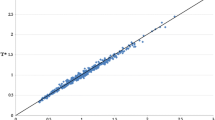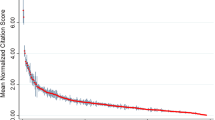Abstract
Cross-field comparison of citation measures of scientific achievement or research quality is severely hindered by the diversity of the stage of development and citation habits of different disciplines or fields. Based on the same principles of RCR (Relative Citation Rate) and RW (Relative Subfield Citedness), a new dimension — the Relative Superiority Coefficient (SC n ) in research quality was introduced. This can indicate clearly the relative research level for research groups at multiple levels in the respective field by consistent criteria in terms of research quality. Comparison of the SC n within or across 22 broad fields among 5 countries were presented as an application model. Hierarchical Cluster and One-Way ANOVA were applied and processed by the statistical program SPSS. All original data were from Essential Science Indicators (ESI) 1996–2006.
Similar content being viewed by others
References
E. Garfield, Citation indexes to sciences: a new dimension in documentation through association of ideas. Science, 122 (1955) 108–111.
F. Hechta, B. K. Hechta, A. A. Sandberg, The Journal “Impact Factor”: A misnamed, misleading, misused measure. Cancer Genetics and Cytogenetics, 104(2) (1998) 77–81.
S. X. Fang, Utilitarianism Induced by Using SCI as Solely Criterion. http://www.sciencetimes.com.cn/20010819/A6-xw006.htm (≪Science Time≫).
E. Garfield, How to use citation analysis and faculty evaluations, and when is it relevant? Part 1. Current Comments, 6(44) (1983) 354–362.
E. Garfield, Citation data is subtle stuff. A primer on evaluating a scientist’s performance. The Scientist, 1(10) (1987) 9.
E. Garfield, The uses and limitations of citation data as science indicators: an overview for students and nonspecialists. Current Comments, 15(49) (1992) 188–198.
E. Garfield, Journal impact factor: a brief review. Canadian Medical Association Journal, 161(8) (1999) 979–980.
Xiaojun Hu, A Probe on the Scientific Indicators of Documents Citation under Web. Studies in Science of Science, 21(6) (2003) 647–651.
Xiaojun Hu, Jianhong Luo, Biomedical Informatics. Beijing, Press of Times Economic China. 2005.
Xiaojun Hu, A study on the application of Garfield’s Law in faculty evaluations. Library and Information Service, (8) (2003) 26–29.
R. West, Impact factors need to be improved. British Medical Journal, 313 (1996) 1400.
A. Schubert, T. Braun, Relative indicators and relational charts for comparative assessment of publication output and citation impact. Scientometrics, 9(5–6) (1986) 281–291.
P. Vinkler, Evaluation of some methods for the relative assessment of scientific publications. Scientometrics, 10(3–4) (1986) 157–177.
P. Vinkler, Relations of relative scientometric impact indicators. The relative publications strategy index. Scientometrics, 40(1) (1997) 163–169.
P. Vinkler, Characterization of the impact of sets of scientific papers: the Garfield (impact) factor. Journal of the American Society for Information Science and Technology, 55(5) (2004) 431–435.
T. Hayashi, Y. Fujigaki, Differences in knowledge production between disciplines based on analysis of paper styles and citation patterns. Scientometrics, 46(1) (1999) 73–86.
Chongde Wang, Introduction of Document Metrology. Guangxi, Press of Guangxi Normal College. 1997.
Essential Science Indicators, http://portal.isiknowledge.com/portal.cgi?DestApp=ESI&Func=Frame
E. Garfield, A. Welljams-Dorof, Citation data: their use as quantitative indicatiors for science and technology evaluation and policy-making. Science and Public Policy, 19(5) (1992) 321–327.
P. Korhonen, R. Tainio, J. Wallenius, Value efficiency analysis of academic research. European Journal of Operational Research, 130(1) (2001) 121–132.
H. F. Moed, Measuring China’s research performance using the Science Citation Index Scientometrics, 53(3) (2002) 281–296.
H. Van den Berghe, J. A. Houben, R. E. de Bruin, et al., Bibliometric indicators of university research performance in Flanders. Journal of the American Society for Information Science, 49(1) (1998) 59–67.
D. Swinbanks, R. Nathan, R. Triendl, Western research assessment meets Asian cultures. Nature, 389(6647) (1997) 113–117.
M. Bordons, M. T. Fernandez, I. Gomez, Advantages and limitations in the use of impact factor measures for the assessment of research performance in a peripheral country. Scientometrics, 53(2) (2002) 195–206.
G. Williams, Misleading, unscientific, and unjust: the United Kingdom’s research assessment exercise. British Medical Journal, 316(7137) (1998) 1079–1082.
P. R. Thomas, D. S. Watkins, Institutional research rankings via bibliometric analysis and direct peer review: A comparative case study with policy implications. Scientometrics, 41(3) (1998) 335–355.
J. Adams, Research assessment in the UK. Science, 296(5569) (2002) 805.
I. Stewart, Reassessing research assessment in the UK. Science, 296(5574) (2002) 1802.
K. Jamrozik, D. P. Weller, R. F. Heller, Research assessment: there must be an easier way. Medical Journal of Australia, 180(11) (2004) 553–554.
E. Garfield, Evaluating research: Do bibliometric indicators provide the best measures? Current Contents, 12(14) (1989) 93.
T. N. van Leeuwen, H. F. Moed, R. J. W. Tijssen, M. S. Visser, A. F. J. van Raan, Language biases in the coverage of the Science Citation Index and its consequences for international comparisons of national research performance. Scientometrics, 51(1) (2001) 335–346.
T. Luukkonen, Bibliometrics and evaluation of research performance. Annals of Medicine, 22(3) (1990) 145–150.
P. O. Seglen, Why the Impact factor of journals should not be used for evaluating research. British Medical Journal, 314(7079) (1997) 498–502.
A. Rostami-Hodjegan, G. T. Tucker, Journal impact factors: a ‘bioequivalence’ issue? British Journal of Clinical Pharmacology, 51(2) (2001) 111–117.
G. H. Whitehouse, Impact factors: facts and myths. European Radiology, 12(4) (2002) 715–717.
E. Garfield, Fortnightly review: how can impact factors be improved. British Medical Journal, 313(7054) (1996) 411–413.
Author information
Authors and Affiliations
Corresponding author
Rights and permissions
About this article
Cite this article
Hu, X. Relative Superiority Coefficient of papers: A new dimension for institutional research performance in different fields. Scientometrics 72, 389–402 (2007). https://doi.org/10.1007/s11192-006-1733-1
Received:
Published:
Issue Date:
DOI: https://doi.org/10.1007/s11192-006-1733-1




